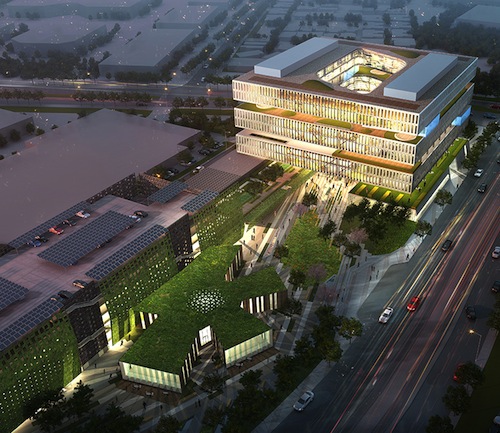Samsung Electronics will enter the Silicon Valley rivalry for best technology-oriented campus with its new headquarters design. The 1.1 million-sf San Jose campus, calculated to give Apple, Facebook and other local high-tech firms a run for their architectural money, will support at least 2,500 sales and R&D staff in Samsung's semiconductor and display businesses.
A pair of linked, 10-story office buildings, encompassing a combined 680,000 sf, will be the hallmark structure. Extensive "green floors" will be provided on every third story, creating a stack of alternating enclosed and open spaces. The gardens will be available to employees for informal breaks and organized recreation. Adjacent facilities will be connected by elevated walkways.
In addition to offices, the program includes research space, a cleanroom, a data center, basketball and sports courts, and cafés in a star-shaped amenities building. A parking structure for more than 1,500 vehicles will feature a rooftop solar array. NBBJ, also the architect behind the recently announced Google Bay View campus, is helming the project.
Samsung Information Systems America is getting new quarters as well. The company has signed a 15-year lease for two six-story buildings in Mountain View's Cypress Business Park, comprising about 385,000 sf.
The state of California is providing an R&D tax credit and an unspecified reimbursement for employee training. The city of San Jose is pitching in with a reduction of traffic impact fees (by more than 50%), a 75%+ reduction in construction taxes, a 50% rebate of up to half of utility taxes for 10 years, and a direct $500,000 economic incentive.
(http://articles.latimes.com/2013/feb/18/business/la-fi-samsung-silicon-valley-20130218)
Related Stories
| May 18, 2011
Carnegie Hall vaults into the 21st century with a $200 million renovation
Historic Carnegie Hall in New York City is in the midst of a major $200 million renovation that will bring the building up to contemporary standards, increase educational and backstage space, and target LEED Silver.
| May 17, 2011
Redesigning, redefining the grocery shopping experience
The traditional 40,000- to 60,000-sf grocery store is disappearing and much of the change is happening in the city. Urban infill sites and mixed-use projects offer grocers a rare opportunity to repackage themselves into smaller, more efficient, and more convenient retail outlets. And the AEC community will have a hand in developing how these facilities will look and operate.
| May 17, 2011
Architecture billings index fell in April, hurt by tight financing for projects
The architecture billings index, a leading indicator of U.S. construction activity, fell in April, hurt by tight financing for projects. The architecture billings index fell 2.9 points last month to 47.6, a level that indicates declining demand for architecture services, according to the American Institute of Architects.
| May 17, 2011
Sustainability tops the syllabus at net-zero energy school in Texas
Texas-based firm Corgan designed the 152,200-sf Lady Bird Johnson Middle School in Irving, Texas, with the goal of creating the largest net-zero educational facility in the nation, and the first in the state. The facility is expected to use 50% less energy than a standard school.
| May 17, 2011
Gilbane partners with Steel Orca on ultra-green data center
Gilbane, along with Crabtree, Rohrbaugh & Associates, has been selected to partner with Steel Orca to design and build a 300,000-sf data center in Bucks County, Pa., that will be powered entirely through renewable energy sources--gas, solar, fuel cells, wind and geo-thermal. Completion is scheduled for 2013.
| May 17, 2011
Should Washington, D.C., allow taller buildings?
Suggestions are being made that Washington revise its restrictions on building heights. Architect Roger Lewis, who raised the topic in the Washington Post a few weeks ago, argues for a modest relaxation of the height limits, and thinks that concerns about ruining the city’s aesthetics are unfounded.
| May 17, 2011
The New Orleans master plan
At an afternoon panel during last week's AIA National Conference in New Orleans, Goody Clancy Principal David Dixon and Manning Principal W. Raymond Manning shared their experiences creating the New Orleans Master Plan, a document that sets a new course for the city, from land use and transportation planning to environmental protection.
| May 17, 2011
Do these buildings look like buffalo to you?
It’s hard to contemplate winter now that we’re mid-spring, but when the seasons change, ice skaters in Winnipeg will be able to keep warm in plywood shelters designed by Patkau Architects. The designers created temporary shelters inspired by animal behavior—specifically, buffalo bracing against the wind. Check them out.
| May 16, 2011
USGBC and AIA unveil report for greening K-12 schools
The U.S. Green Building Council and the American Institute of Architects unveiled "Local Leaders in Sustainability: A Special Report from Sundance," which outlines a five-point national action plan that mayors and local leaders can use as a framework to develop and implement green schools initiatives.












